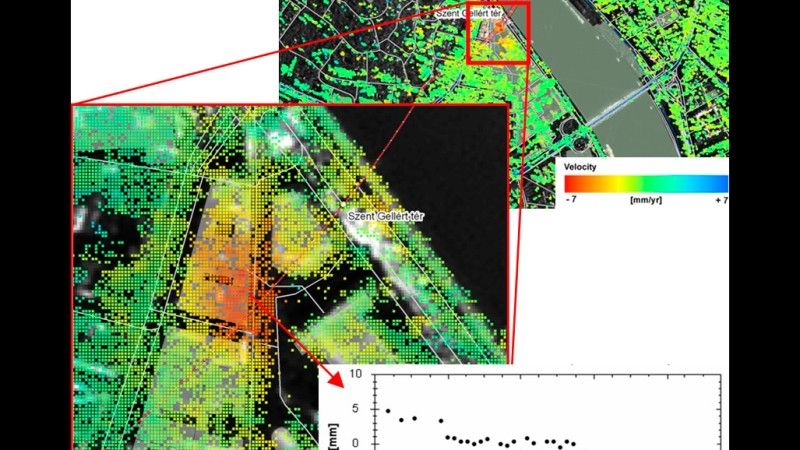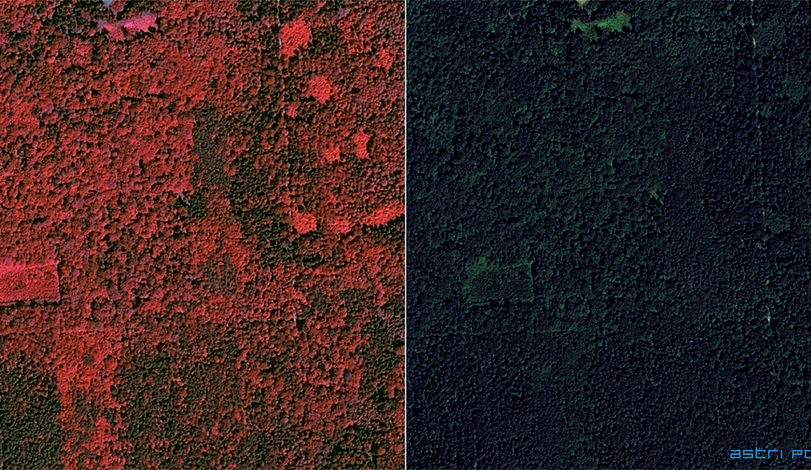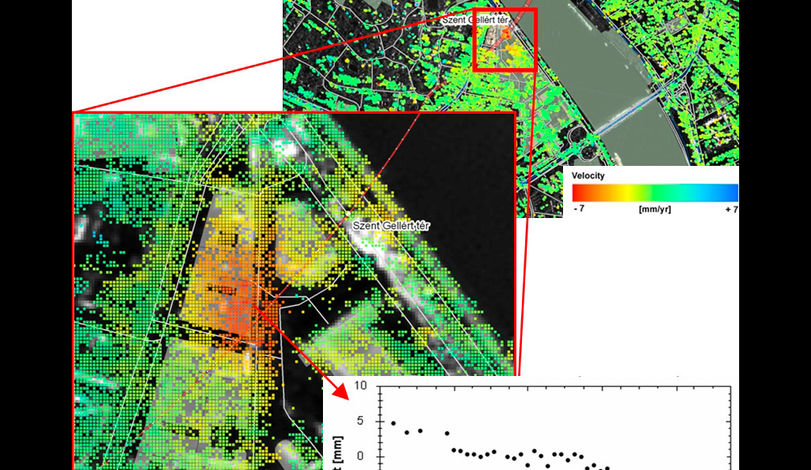
Satellite Imagery. A Modern Foundation for Economic Development and Security [ANALYSIS]
Throughout the last few decades, our ability to inspect the surface of the Earth, with the use of hardware orbiting in the outer space, has been greatly expanded.The imagery and data obtained in this way, acquired through processing of the information gathered by the satellites, are widely used today, across numerous domains of life of modern communities. Distribution and processing of such imagery involves, to a great extent, Polish entities.
The non-military EO Satellites are orbiting on a low orbit, at altitudes of several hundred kilometres. The ones placed in heliosynchronous, polar orbits, remain capable of covering the whole area of the Earth. They travel around the globe in around 100 minutes.
Among the Earth Observation satellites, one may list several, basic types of instruments. Above all, optical satellites shall be included within the category, providing the images of the planet within the visible light spectrum. Optoelectronic satellites have a greater capability, since they inspect the planet within a wider range of spectrum of the electromagnetic radiation. Thanks to the above, they remain capable of examining the desired area in infra-red, noticing the temperature differences, which may be especially useful at night for instance. Finally, radar satellites exist, creating maps of topography of the given area, through analysis of electromagnetic waves dissipated and reflected by the terrain, with such signals being sent from the orbit.
Earth Observation satellites are not usually placed at orbits higher than 500-600 kilometres. Any lower trajectory would require the instrument to carry out frequent manoeuvrers, due to the resistance caused by the residual atmosphere. Even though the satellite imagery offers resolution different from that of aerial photography, it bears numerous advantages when compared to the latter data:
-
The imagery gathered by satellites may turn out to be cheaper, especially in cases when high resolution is not required;
-
The satellite imagery may be gathered within the areas inaccessible for the aircraft, e.g. close to the border or above the airports;
-
The satellite imagery makes it easier to obtain homogeneous data for large areas, ortophotomaps are quicker to be obtained, in comparison with the aerial photography.
EO - Wide Field of Application
The information gathered thanks to the satellite imagery is being used across numerous domains of the economy, including land surveying, cartography, energy sector, forestry and water management, for example for the purpose of analysing riverbeds shape changes across time. The satellites also facilitate provision of security and allow for monitoring of the borders. In crisis management scenarios they turn out to be an indispensable tool making it easier to carry out rescue operations and to neutralize and mitigate the results of natural catastrophes.

One may list a number of very specific examples of use for the EO data. Back in 2016, a pair of Sentinel-1 satellites has noticed an unbalanced subsidence in case of one of the newest San Francisco skyscrapers. In Poland, SATIM company exists, the employees of which, using the satellite imagery, examine the stability of buildings, monitor the landslides and vertical movement of the surface of the Earth, making it possible to observe road deformations and vertical displacement of the infrastructure.
SATIM, in collaboration with the Astri Polska company, has been, for instance, monitoring the subsidence of the ground for the Jastrzębie-Zdrój City Hall. The service is provided on the basis of the data gathered by the SAR satellites. The city mentioned above is prone to danger for the population and for the environment, that may be caused by the mining activities taking place at the coal mines located in the region. Thanks to a comparison of radar imagery gathered in September 2015 and in February 2016, it was possible to estimate that 30 cm difference has occurred with regards to the ground level in some parts of the city. The aforesaid data made it possible to identify the areas prone to subsidence, and in the future, this would allow for implementation of proper countermeasures. Jastrzębie-Zdrój is a prime example of the meaning and role the good practices of using the satellite data by the public administration, for the local communities.
SatAgro start-up company, working together with the Polish Grupa Azoty company, has prepared a specialized application dedicated for agricultural use. Thanks to the aforesaid solution, the farmers may, using the satellite data provided by Astri Polska, in an ongoing manner, monitor their crops, effects of the weather conditions and agronomic activities. The Instrument in question allows for effective crops management, maximizing the use of the agricultural area, with diminished cost of fertilizing and heightened benefits for the environment.
The satellite data is also being mass-used by resource companies, such as the KGHM tycoon from Poland.
Analysis of satellite imagery is (...) one of the first techniques used in the domain of exploration of metal deposits in hardly accessible areas such as deserts or steppes. The imagery allows for identification of geological structures, lineaments or zones of surface rock transformations that may be the first symptom as to where the exploration shall begin. During the exploration itself, the satellite imagery is used to create topographic maps, not only showing the terrain shape or the hydrographic network, but also the infrastructural elements, such as the degree of urbanization or access roads for the locations where the surface geophysical research and drilling works are to be conducted.
Alongside the commercial entities, research and scientific institutes also make use of the Earth observation data. Warsaw Institute Geodesy and Cartography (IGiK) and its Centre for Remote Sensing has gathered a great deal of experience in this area. At the moment, the employees of the centre are in process of implementing a number of projects with the use of optical spectrum data (visible, thermal) and radar data in the domains such as agriculture (crops forecast, drought detection and monitoring, crops reconnaissance, estimating the crops conditions), monitoring of the Natura2000 swamp areas (energy and water balance, monitoring the changes of soil humidity), or examining the changes of ground cover in agricultural and urbanized areas.
The Polish Geological Institute also carries out research and remote-sensing monitoring with the use of satellite and aerial imagery, and altitude data provided by LIDAR systems. The remote-sensing specializing representatives of the aforesaid entity deal with the following activities:
- Digital analysis and processing of satellite, radar and aerial imagery;
- Photo-geological analysis of satellite imagery, carried out through recognition of tectonic structures, lithology and surface changes of the area;
- Analysis of satellite radar interferometry imagery;
The plant life and land use effectively camouflage any symptoms of geological activities. A breakthrough came when radar data was used. (...) more intense use of radar date took place along with development of SAR satellites (ERS-1 and ERS-2 systems) and development of InSAR satellite radar interferometry methods. The interferometry itself, on the basis of comparison of radar signal phases from the subsequently recorded data, allows for tracking of altitude changes of the land surface. This allows for monitoring of the areas where underground exploitation is taking place (subsidence) and geo-threats (mass movements) (...) InSAR data is also used by us to monitor the landslides. Meanwhile, we are also working on using the InSAR imagery to monitor the gas-fracking [hydraulic fracturing] areas (...). Next year, following the order placed by the Ministry of Environment, we will begin work on a service which, on the basis of the Sentinel-1 database, would make it possible to develop a land deformation map of Poland. The map in question is going to be updated every six months, with the digital data being generally accessible via the geological data geoportal: PIG-PIB IKAR.
The free data provided by the Sentinel-1 satellites also has a quite wide field of use. For some purposes, more detailed radar imagery would be required. Such data can be provided by the Airbus Defence and Space TerraSar-X and TanDem-X satellites. The need for use of such data has occured e.g. during the Budapest subway construction works.

The EO data may be also widely applied in crisis management scenarios. This domain is an area of interest of the Centre of Crisis Information which is a part of the Polish Academy of Sciences Space Research Centre. The remote-sensing techniques allow for production of accurate maps that are up to date. Within the scope of crisis management, alongside acquisition of very high, high, medium and low resolution satellite imagery, one also utilizes radar instruments that make it possible to acquire imagery of the given area regardless of the weather conditions and regardless of the time of day. What is interesting, both during the rescue operations, as well as in crisis management, satellite navigates are being widely applied for the purpose of monitoring the vehicle fleets and in mobile applications based on the geographical data.
European Projects
Widely understood satellite observations are, in the contemporary context, an important policy- and development-shaping instrument. EO4EP initiative (Earth Observations for Eastern Partnership) is a good example here. The said undertaking is a part of the wider EO4SD project (Earth Observations for Sustainable Development). Here we are referring to usage of EO data for sustainable development of Eastern Partnership countries - Poland, Georgia, Armenia and Moldavia, in domains such as agriculture or water management. The goal of the programme is to prepare products and services based upon the EO data, for the purpose of being used in development initiatives of the World Bank and the European Investment bank, and to enhance the options of using such products and services among the local users in the target countries. Astri Polska and GEOSYSTEMS Polska companies are the entities that offer their products and services within the EO4EP project in Poland, under the guidance of the Centre of Crisis Information of the Polish Academy of Sciences Space Research Centre.
Copernicus is the flagship EU EO programme. It is being implemented by the European Commission for the European Community. It is to provide the citizens of Europe with knowledge of the current state of the planet and changes happening on Earth. The initiative also makes a great contribution to the economic development of the EU member states.
Sentinel optical and radar satellites act as an important orbital component of the Copernicus programme. Astri Polska, together with the KAPITECH company form one of the two domestic consortia, officially designated by the Commission to promote the use of data gathered within the framework of the Copernicus programme.
Commercial service providers, providing this type of services, also play an important role on the European satellite imagery market. Airbus Defence and Space is one of the most significant entities that carries out business activities in this domain. The company has a SPOT (Satellite Pour l’Observation de la Terre) satellite constellation at its disposal, among other assets. SPOT 6 and SPOT 7 instruments cover up to 6 million square kilometres daily, which is more than the area of the whole EU territory, providing naturally coloured imagery with 1.5 m resolution.
Astri Polska company mentioned above represents Airbus in Poland. The entity is a joint venture company formed by Airbus Defence & Space and the leading domestic space research facility - the Polish Academy of Sciences Space Research Centre. As a distributor of the AD&S satellites imagery, Astri Polska offers access to high quality satellite radar and optical imagery. The former data comes from the TerraSAR-X/TanDEM-X satellites which are soon to be joined by the PAZ (Q4 2017) instrument. The latter data is being gathered by Pleiades 1A and 1B platforms capable of delivering 20 km wide imagery on short notice. With daily revisit at virtually any location, the aforesaid satellites deliver imagery with resolution of 0.5 meters per pixel. Pleiades constellation is a dual-use system, the purpose of which is both civil, as well as military use - it gathers data for the French Armed Forces.
Added Value of Imagery Processing
Not only is the raw imagery gathered by the satellites a response to the current market demand, as more and more value is ascribed to the processed data and information derived from databases including the data gathered by the orbiting instruments. The image processing and obtaining custom-tailored data feeds requires mighty computing abilities.
Astri Polska offers products based on innovative use of the EO data. 3D City is one of the examples - it is a tool used for generation of 3D urban area models in real time. The application allows the user to enhance the model with textures or special effects related to the time of day or distribution of shadows. The system allows for visualizing urban compounds and building interiors with the use of a web browser, providing the user with a three-dimensional city model featuring details of the buildings, urban infrastructure or the greenery. The model may be further enhanced with more layers, such as ortophotomaps, topographic or historical maps.
3D City service is applied in the areas where a complex land development and landscape architecture analyses are required. It is also possible to use the said tool to promote the city online.
The satellite segment, both in the radar, as well as optical imagery domains, also bears a great degree of importance in the SAFEDAM project, also involving the Astri Polska company, along with the Faculty of Land Surveying and Cartography of the Warsaw University of Technology and the Institute of Meteorology and Water Management.
SAFEDAM’s objective is to create a system which would monitor the anti-flood dams. SAFEDAM assumes that satellite imagery is used to monitor areas covered by water, on the basis of the data provided by the Sentinel constellation. The critical areas detected will be laser-scanned by a drone, with measurement accuracy brought down to 1 centimetre.
A complex IT suite would allow for gathering and automatic analysis of 3D data and visualization of that data for the hydrology and crisis management experts. Implementation of the aforesaid solution would allow for effective flood risk management. The programme is co-financed by the National Centre for Research and Development.
Earth Observation as a Foundation of Development for the Space Sector
According to Euroconsult, throughout the period between 2006 and 2015, 194 EO satellites weighing more than 50 kilograms were sent into the orbit. Meanwhile, in the period between 2016 and 2025, twice as much such platforms would be launched - 419 examples. The market value, when it comes to commercial EO, has reached the amount of USD 1.7 billion in 2015, and is expected to go up to 3 billion dollars in 2025.
EO is a domain of the space sector in which, numerous countries, make their first steps within the space domain. It seems that such path would also be right for Poland. The domestic entities have already acquired relevant expertise in processing and distribution of satellite imagery. Now is the time to place own EO satellite in the space, or even a constellation of smaller devices belonging to this category. It is also important to maximize the contribution of domestic companies within such programme, providing them with relevant experience and reinforcing their reputation on the tough European and global space technology markets.
WIDEO: Defence24 Days 2025: Premier Defence & Security Conference in CEE